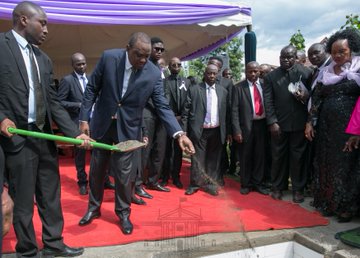Kenya and Jamaica have pledged to deepen bilateral and people-to-people ties for the benefit of the two countries.
The commitment came as President Uhuru Kenyatta, who is in Jamaica for a historic state visit, held bilateral talks with his host Jamaican Prime Minister Andrew Holness on Monday afternoon.
The two leaders, who met at the Office of the Prime Minister in Kingston, witnessed the signing of four agreements among them MoUs on technical cooperation in tourism and in the fields of sports, culture and heritage as well as a framework of cooperation between the two governments and an MoU on political consultations.
Besides the signed agreements, the two leaders and their delegations held a bilateral meeting during which plans to introduce air transport connections between Kenya and Jamaica were discussed.
Both leaders said air transport between Kenya and the Caribbean will lead to more economic interaction which will in turn help economic growth for the people of both countries.
In their talks, President Kenyatta and PM Holness explored existing opportunities for cooperation in air transport with the Kenyan leader saying that flights from the East Coast of Africa to Jamaica will help strengthen economic ties between Caribbean countries and the African continent.
“Our national carrier now has scheduled direct flights from Nairobi to New York but we would like to see flights flying from the East Coast to the West Coast of Africa and directly to Jamaica, and through Jamaica to the rest of the Caribbean as a true way of deepening our partnership,” President Kenyatta said.
President Kenyatta said one sure way of deepening the partnership between Kenya and Jamaica is to encourage more trade and deepen commercial ties between the two countries.
“We need to deepen our trade because by so doing we also take our people-to-people relations to the next level. Kenya is today one of the largest and one of the most diversified economies on the African continent,” the President said.
He said Kenya serves as a hub for logistics and transport, financial services, ICT innovations, as he encouraged Jamaican investors to come to Kenya.
The two leaders also discussed ways of strengthening cooperation between Kenya and Jamaica in the blue economy which they said holds tremendous potential for wealth and job creation.
On the multilateral front, President Kenyatta said Kenya is a strong supporter of the South-South Cooperation arrangements within the African Caribbean Pacific (ACP) states framework and assured his host that his administration will continue pushing for the conclusion of a successor agreement ahead of the expiry of the Cotonou Agreement in February of next year.
Kenya will host the next ACP summit at the end of the year at which time PM Holness is expected to visit Kenya.
As part of the deals that were signed between Kenya and Jamaica, the Global Tourism Resilience and Crisis Management Center which is based at the University of West Indies will open its first satellite centre in Nairobi and will be based at the University of Nairobi.
In the area of sports, the two leaders said Kenya and Jamaica will cooperate in sports development especially in athletics, a sport in which the two counties are global icons with Kenya leading in medium and long distances while Jamaica being a perennial global record setter in short distance running.
PM Holness said Kenya and Jamaica have had strong ties from the days of Marcus Garvey whose teachings of African unity had a strong impact on Kenya’s push for independence from the British rule in the 1960’s.
“Jamaica, Kenya relations are deeply rooted. It is well documented that our first national hero The Right Excellent Marcus Mosiah Garvey had significant influence on Jomo Kenyatta, the first Prime Minister of Kenya and later its first President,” said PM Holness.
“In that context we also recall the late Dudley Thompson as a Jamaican lawyer and Pan Africanist in East Africa. He was resolute in his staunch defence of Jomo Kenyatta when he was charged with treason by the British colonialist government of the day,” the PM continued.
He said the deep historical ties have played a big role in the long standing solidarity between Kenya and Jamaica, adding that the two countries should capitalise on the strong foundation to create stronger economic ties for the benefit of their people.
Earlier, President Kenyatta who is accompanied by First Lady Margaret Kenyatta, was received by his host Prime Minister Holness and Governor General Patrick Allen in a colorful state reception that included a full guard of honour mounted by the Jamaica Defence Forces and a 21-gun salute upon his landing at the Norman Manley International Airport in Kingston.
On Tuesday, President Kenyatta will be the chief guest at the 57th Jamaica Independence Day.
Before the independence anniversary festival, the President will be the chief guest at the 67th Denbigh Agricultural, Industrial and Food Show in Clarendon.
President Kenyatta’s visit comes at a time when the Caribbean is commemorating the 400th anniversary of the first arrival of African slaves in the Americas.
Promoters of closer links between Africans in the diaspora and the people of the continent are marketing the anniversary as the year of the return.


















